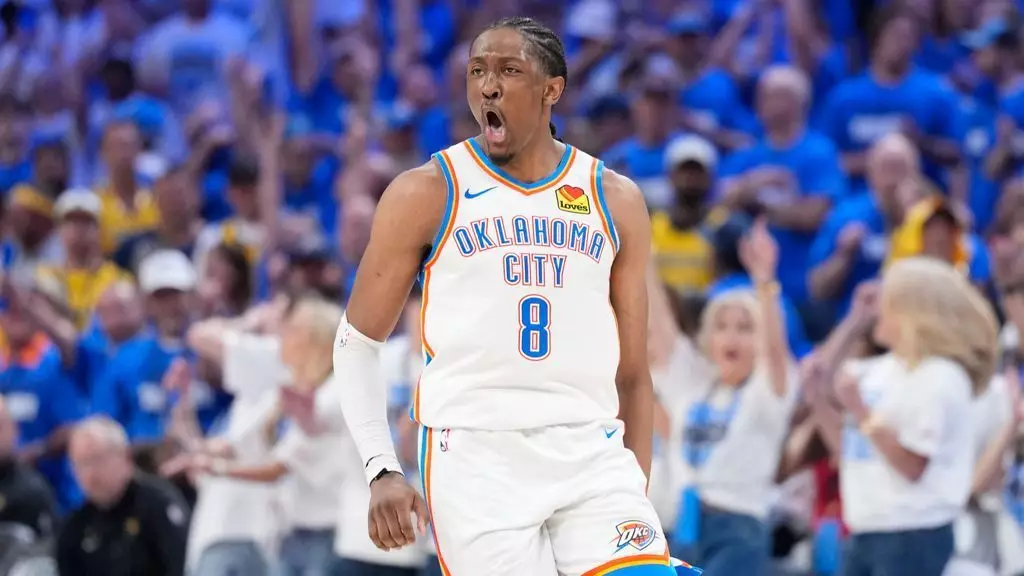The Oklahoma City Thunder are making a daring statement to the NBA world with their aggressive contract extensions for their core players. By securing long-term deals for rising stars like Shai Gilgeous-Alexander, Chet Holmgren, and Jalen Williams, the franchise positions itself as a team willing to finance future success. However, beneath the surface of this strategic consolidation lies a complex debate about sustainability, fiscal responsibility, and team-building philosophy. While some argue that investing heavily in youth with high upside guarantees the team’s competitive window, others see this as a reckless gamble that could entrap the franchise into a lengthy financial quagmire.
The decision to extend Jalen Williams with a five-year maximum rookie deal, potentially reaching $287 million, reflects confidence in his remarkable progress. His performance, highlighted by a deep playoff run and clutch moments—most notably his 40-point game in the Finals—secures his place as a cornerstone. Yet, that performance came amidst adversity, as Williams battled a wrist injury that eventually required surgery. This raises a critical question: should a team be so committed to a player who already faces significant injury risks early in his career? The risk is that the Thunder are placing an enormous bet on Williams’ health and continued development, which may or may not pay off.
The Double-Edged Sword of Championship Aspirations
The Thunder’s ambitious pursuit of a championship core, built around their “Big 3,” signals a franchise determined to contend at the highest level. Their recent title, achieved while still considered a relatively young team in NBA history, is a testament to their rapid growth. Yet, the path to sustained success in an increasingly competitive league is fraught with challenges, especially when a team is willing to spend beyond traditional limits.
Entering the 2025-26 season, Oklahoma City projects a payroll surpassing the luxury tax threshold, a move that reveals a desire to win now while also risking future flexibility. In 2026-27, their payroll might hit $246 million, well above the luxury tax apron, which could restrict their ability to maneuver in future seasons. The team also holds $77 million in non-guaranteed contracts, presenting both an opportunity for flexibility and a potential obstacle if these players fail to develop as hoped.
The core question here revolves around strategic patience versus aggressive expenditure. Does the franchise believe that immediate victory outweighs the long-term financial health? This aggressive approach may reap immediate rewards, but history suggests that overextending financially can lead to Cap management crises, roster instability, and diminished competitive longevity. The Thunder’s decision is emblematic of a broader debate about whether teams should chase short-term success at the expense of sustainable growth or adopt a patient, disciplined approach.
The Cultural and Ethical Implications of High-Stakes Spending
In a league increasingly dominated by superstars commanding colossal salaries, Oklahoma City’s strategy raises broader questions about fairness, league parity, and the ethical considerations of wealth concentration. The team’s willingness to spend heavily on a young core exemplifies a broader trend where a few teams overshadow the rest with financial might, potentially undermining competitive balance.
While some may argue that this level of investment is justified in pursuit of championships, it also perpetuates an uneven playing field, fostering a league where success often correlates more with payroll than strategic ingenuity. Moreover, the financial strain placed on teams that overspend might have a ripple effect, impacting salary cap management across the league and influencing the overall health of the NBA.
Furthermore, from a center-left liberal perspective, this approach prompts reflection on economic inequality within professional sports. The vast disparity in player salaries and franchise spending raises questions about the ethical responsibilities of owners and the league to promote more equitable revenue sharing and competitive balance. Is the drive for immediate success worth potentially undercutting the league’s integrity and long-term viability? Balancing ambition with social responsibility remains a critical challenge for the NBA and its franchises, including Oklahoma City.
The Future of the Thunder: Risks, Rewards, and Reform
Oklahoma City’s bold moves might pay off with a sustained title run, but they also risk fostering a fragile roster dependent on young players whose health and consistency remain uncertain. The team’s gamble to combine youth, high-end talent, and financial firepower is a high-wire act—one that could either vault them to dominance or plunge them into payroll chaos.
As the league navigates an era of unprecedented financial stakes, it becomes increasingly vital for teams like the Thunder to weigh immediate ambitions against the principles of fair competition and long-term responsibility. Their strategy exemplifies the tension at the heart of contemporary NBA team-building: a desire for instant legacy versus the need for sustainable growth within the league’s broader ecosystem. Achieving the right balance will determine whether Oklahoma City’s recent success is a blueprint for the future or a cautionary tale of hubris in professional sports.


Leave a Reply